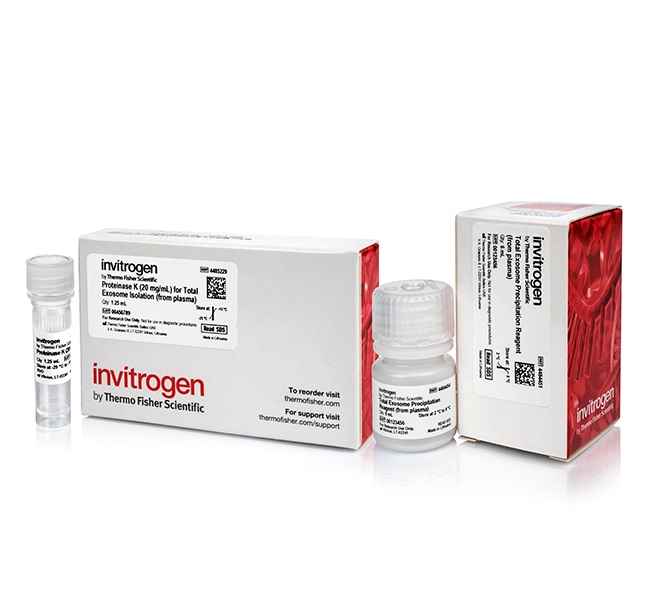Search Thermo Fisher Scientific

Invitrogen™
Total Exosome Isolation Kit (from plasma)
トータルエキソソーム単離試薬(血漿用)は、血漿用サンプルからインタクトなエキソソームを迅速かつ効率的に濃縮します。このキットは、トータルエキソソーム単離試薬(血漿用)およびプロテイナーゼK(20 mg/mL詳細を見る
| 製品番号(カタログ番号) | 数量 |
|---|---|
| 4484450 | 6 mL |
製品番号(カタログ番号) 4484450
価格(JPY)お問い合わせください ›
63,600
Each
数量:
6 mL
トータルエキソソーム単離試薬(血漿用)は、血漿用サンプルからインタクトなエキソソームを迅速かつ効率的に濃縮します。このキットは、トータルエキソソーム単離試薬(血漿用)およびプロテイナーゼK(20 mg/mL)の2つから成ります。トータルエキソソーム単離試薬(血漿用)は、サンプルサイズに合わせてスケールアップ、スケールダウンが可能なプロトコルで、血漿サンプルからインタクトなエキソソームを簡単かつ確実に濃縮します。プロテアーゼKは、任意で行う血漿の前処理用に別個に提供されます。プロテアーゼKを使用して血漿タンパク質をすべて除去することで、最高純度のエキソソームが得られます。
•あらゆる種類の下流アプリケーションで使用できるインタクトなエキソソームの回収率を最大化
• シンプルかつ信頼性の高いプロトコルで簡単にエキソソームを分離
• 時間のかかる超遠心分離は不要
• 最大限の柔軟性—サンプルサイズに合わせてスケールアップまたはスケールダウンが可能
トータルエキソソーム単離試薬は、水分子を結合させることにより、小胞など溶解性の低い成分を溶液外に押し出し、短時間の低速遠心による回収を可能にします。プロテイナーゼKで10分間処理した後、試薬を血漿に加え、溶液を2–8℃で30分間インキュベートします。沈殿したエキソソームを室温で10,000 x g、5分間の標準的な遠心分離で回収します。次いでペレットをPBSまたは同様のバッファーに再懸濁すれば、エキソソームを下流の解析またはアフィニティー法による次段階の精製で使用できるようになります。その後、トータルエキソソームRNAタンパク質単離キット(カタログ番号4478545)を使用してトータルRNAとタンパク質を精製できます。インタクトなエキソソームを経路、機能、輸送などの生物学的研究に使用することもできます。
下流の質量分析では、分析前にゲル電気泳動による単離エキソソーム懸濁液の精製を行うことを推奨します。
•あらゆる種類の下流アプリケーションで使用できるインタクトなエキソソームの回収率を最大化
• シンプルかつ信頼性の高いプロトコルで簡単にエキソソームを分離
• 時間のかかる超遠心分離は不要
• 最大限の柔軟性—サンプルサイズに合わせてスケールアップまたはスケールダウンが可能
トータルエキソソーム単離試薬は、水分子を結合させることにより、小胞など溶解性の低い成分を溶液外に押し出し、短時間の低速遠心による回収を可能にします。プロテイナーゼKで10分間処理した後、試薬を血漿に加え、溶液を2–8℃で30分間インキュベートします。沈殿したエキソソームを室温で10,000 x g、5分間の標準的な遠心分離で回収します。次いでペレットをPBSまたは同様のバッファーに再懸濁すれば、エキソソームを下流の解析またはアフィニティー法による次段階の精製で使用できるようになります。その後、トータルエキソソームRNAタンパク質単離キット(カタログ番号4478545)を使用してトータルRNAとタンパク質を精製できます。インタクトなエキソソームを経路、機能、輸送などの生物学的研究に使用することもできます。
下流の質量分析では、分析前にゲル電気泳動による単離エキソソーム懸濁液の精製を行うことを推奨します。
研究用にのみ使用できます。診断用には使用いただけません。
仕様
最終産物タイプエキソソーム
フォーマット液体
数量6 mL
製品タイプTotal Exosome Isolation Kit
Unit SizeEach
組成および保存条件
• 6 mLのトータルエキソソーム沈殿試薬(血漿用)。2~8℃で保存してください。
• トータルエキソソーム単離(血漿用)(20 mg/mL)に使用する1.25 mLのプロテイナーゼK。-5~-30℃で保存。
• トータルエキソソーム単離(血漿用)(20 mg/mL)に使用する1.25 mLのプロテイナーゼK。-5~-30℃で保存。
Have questions about this product? Ask our AI assisted search.
This is an AI-powered search and may not always get things right. You can help us make it better with a thumbs up or down on individual answers or by selecting the “Give feedback" button. Your search history and customer login information may be retained by Thermo Fisher and processed in accordance with our
Privacy Notice.